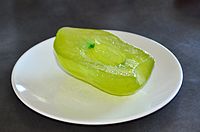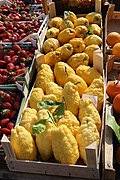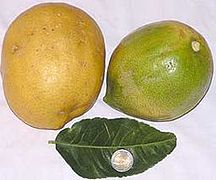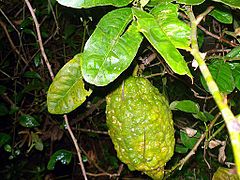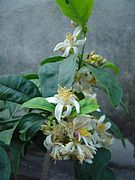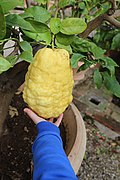Citron
| Citron | |
|---|---|
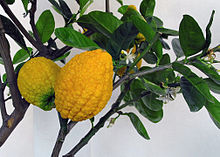
| |
| Scientific classification | |
| Kingdom: | Plantae |
| Clade: | Tracheophytes |
| Clade: | Angiosperms |
| Clade: | Eudicots |
| Clade: | Rosids |
| Order: | Sapindales |
| Family: | Rutaceae |
| Genus: | Citrus |
| Species: | C. medica
|
| Binomial name | |
| Citrus medica | |
| Synonyms[2][3] | |
The citron (Citrus medica), historically cedrate,[4] is a large fragrant citrus fruit with a thick rind. It is said to resemble a 'huge, rough lemon'.[5] It is one of the original citrus fruits from which all other citrus types developed through natural hybrid speciation or artificial hybridization.[6] Though citron cultivars take on a wide variety of physical forms, they are all closely related genetically. It is used in Asian and Mediterranean cuisine, traditional medicines, perfume, and religious rituals and offerings. Hybrids of citrons with other citrus are commercially more prominent, notably lemons and many limes.
Etymology
The fruit's English name "citron" derives ultimately from Latin, citrus, which is also the origin of the genus name.
Other languages
A source of confusion is that 'citron' in French and English are false friends, as the French word 'citron' refers to what in English is a lemon; whereas the French word for the citron is 'cédrat'. Indeed, into the 16th century, the English term citron included the lemon and perhaps the lime as well.[7][failed verification] Other languages that use variants of citron to refer to the lemon include Armenian, Czech, Dutch, Finnish, German, Estonian, Latvian, Lithuanian, Hungarian, Esperanto, Polish and the Scandinavian languages.
In Italian it is known as cedro, the same name used also to indicate the coniferous tree
Dutch merchants seasonally import Sukade for baked goods; a thick, light green colored commercially candied half peeling from Indonesia and other countries (sukade – Indonesian word for love, Citrus médica variety 'Macrocárpa'), which can reach 2.5 kilograms mass. A bitter taste is removed by salt treatment before processing into confectionery.[9]
In Hebrew it is called an etrog (אתרוג). The citron plays an important role in the harvest holiday of Sukkot paired with lulavim (fronds of the date palm).
Origin and distribution
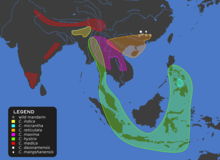
The citron is an old and original citrus species.[11]
There is molecular evidence that most cultivated citrus species arose by
Archaeological evidence for citrus fruits has been limited, as neither seeds nor pollen are likely to be routinely recovered in archaeology.
Antiquity
Leviticus mentions the "fruit of the beautiful ('hadar') tree" as being required for ritual use during the

The
as early as the 3rd millennium BC.The citron has been cultivated since ancient times, predating the cultivation of other citrus species.[32]
Theophrastus
The following description on citron was given by Theophrastus[33]
In the east and south there are special plants ... i.e. in Media(Perhaps they mistakenly called it Mad because it was located in the east of Parthia and south and the tree grows in the question of Caspian sea, Mazandaran, Gilan , not Mad
breath, for if one boils the inner part of the fruit in a dish or squeezes it into the mouth in some other medium, it makes the breath more pleasant.The seed is removed from the fruit and sown in the spring in carefully tilled beds, and it is watered every fourth or fifth day. As soon the plant is strong it is transplanted, also in the spring, to a soft, well watered site, where the soil is not very fine, for it prefers such places.
And it bears its fruit at all
pistil] projecting from the middle are fertile, while those that do not have this are sterile. It is also sown, like date palms, in pots punctured with holes.This tree, as has been remarked, grows in Media and Persia.
Pliny the Elder
Citron was also described by Pliny the Elder, who called it nata Assyria malus. The following is from his book Natural History:
There is another tree also with the same name of "citrus", and bears a fruit that is held by some persons in particular dislike for its smell and remarkable bitterness; while, on the other hand, there are some who esteem it very highly. This tree is used as an ornament to houses; it requires, however, no further description.[37]
The citron tree, called the Assyrian, and by some the Median or Persian apple, is an antidote against poisons. The leaf is similar to that of the arbute, except that it has small prickles running across it. As to the fruit, it is never eaten, but it is remarkable for its extremely powerful smell, which is the case, also, with the leaves; indeed, the odour is so strong, that it will penetrate clothes, when they are once impregnated with it, and hence it is very useful in repelling the attacks of noxious insects.
The tree bears fruit at all seasons of the year; while some is falling off, other fruit is ripening, and other, again, just bursting into birth. Various nations have attempted to naturalize this tree among them, for the sake of its medica or Persian properties, by planting it in pots of clay, with holes drilled in them, for the purpose of introducing the air to the roots; and I would here remark, once for all, that it is as well to remember that the best plan is to pack all slips of trees that have to be carried to any distance, as close together as they can possibly be placed.
It has been found, however, that this tree will grow nowhere except in Persia. It is this fruit, the pips of which, as we have already mentioned, the Parthian grandees employ in seasoning their ragouts, as being peculiarly conducive to the sweetening of the breath. We find no other tree very highly commended that is produced in Media.[38]
Citrons, either the pulp of them or the pips, are taken in wine as an antidote to poisons. A decoction of citrons, or the juice extracted from them, is used as a gargle to impart sweetness to the breath. The pips of this fruit are recommended for pregnant women to chew when affected with
Medieval authors
Ibn al-'Awwam's 12th-century agricultural encyclopedia, Book on Agriculture, contains an article on citron tree cultivation in Spain.[40]
Description and variation
Fruit
The citron fruit is usually
Most citron varieties contain a large number of
Some citrons have medium-sized oil bubbles at the outer surface, medially distant to each other. Some varieties are ribbed and faintly warted on the outer surface. A fingered citron variety is commonly called Buddha's hand.
The color varies from green, when unripe, to a yellow-orange when overripe. The citron does not fall off the tree and can reach 8–10 pounds (4–5 kg) if not picked before fully mature.[41][12] However, they should be picked before the winter, as the branches might bend or break to the ground, and may cause numerous fungal diseases for the tree.
Despite the wide variety of forms taken on by the fruit, citrons are all closely related genetically, representing a single species.[18][42] Genetic analysis divides the known cultivars into three clusters: a Mediterranean cluster thought to have originated in India, and two clusters predominantly found in China, one representing the fingered citrons, and another consisting of non-fingered varieties.[42]
Plant
Citrus medica is a slow-growing
| Citron varieties |
|---|
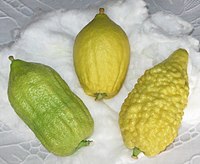 |
| Acidic-pulp varieties |
| Non-acidic varieties |
| Pulpless varieties |
| Citron hybrids |
| Related articles |
The citron tree is very vigorous with almost no dormancy, blooming several times a year, and is therefore fragile and extremely sensitive to frost.[43]
Varieties and hybrids
The
There are also a number of citron hybrids; for example, ponderosa lemon, the lumia and rhobs el Arsa are known citron hybrids. Some claim[45] that even the Florentine citron is not pure citron, but a citron hybrid.
Uses
Culinary
While the
In Samoa a refreshing drink called "vai tipolo" is made from squeezed juice. It is also added to a raw fish dish called "oka" and to a variation of palusami or luáu.
Citron is a regularly used item in Asian cuisine.
Today the citron is also used for the
The dozens of varieties of citron are collectively known as Lebu in Bangladesh, West Bengal, where it is the primary citrus fruit.
In Iran the citron's thick white rind is used to make jam; in
-
A citron halved and depulped, cooked in sugar
-
Cedrata, a citron soft drink from Italy
-
Citron torte
Folk medicine
From
The juice of the citron has a high content of
Religious
In Judaism
The citron (the word for which in Hebrew is In Buddhism
A variety of citron native to
In Hinduism
In
Perfumery
For many centuries, citron's fragrant essential oil (oil of cedrate) has been used in perfumery, the same oil that was used medicinally for its antibiotic properties. Its major constituent is limonene.[52]
See also
- Archaeological finds of citrons in Israel
- Gallery of Etrog citrons
- Gallery of Fingered citrons
- Candied Fruit Peel
Gallery
-
In a German market, for culinary use
-
In fruit market of Italy
-
Naxos citrons and leaf
-
Citron orhybrid in Sicily
-
A wild citron in India
-
Citron flowers
-
Unknown citron type in pot
-
Citron growing in Uttarakhand,
Citations
- ^ Plummer, J. 2021. Citrus medica. The IUCN Red List of Threatened Species 2021: e.T62041221A62041228. Downloaded on 06 September 2021.
- S2CID 242819146.
- ^ "Citrus medica L. Sp. Pl. : 782 (1753)". World Flora Online. World Flora Consortium. 2022. Retrieved 11 December 2022.
- ^ "Cedrate". Collins English Dictionary.
- OCLC 890807357.
- ISBN 978-94-017-9275-2.
- ^ "Home : Oxford English Dictionary". oed.com.
- ^ "Citrus medica" (PDF). plantlives.com. 2 October 2021.
- ISBN 9789022610220.
- ISBN 9782918887775.
- ^ Chambers, William and Robert (1862). Chambers's Encyclopedia: A Dictionary of Universal Knowledge for the People. London: W. and R. Chambers. p. 55, vol. 3.
- ^ a b The Search for the Authentic Citron: Historic and Genetic Analysis; HortScience 40(7):1963–1968. 2005 Archived September 21, 2008, at the Wayback Machine
- S2CID 24057066.
- S2CID 7667126. Archived from the originalon 2021-03-09. Retrieved 2018-12-04.
- .
- S2CID 84015769.
- S2CID 26046238.
- ^ PMID 29414943.
- )
- ^ "Welcome to Encyclopaedia Iranica".
- ^ Inquiry into Plants 4.iv.2.
- JSTOR 142080.
- ^ a b "Citron: Citrus medica Linn". Purdue University.
- ISBN 9780849388040.
- ^ "ethrog". University of California, Riverside. Archived from the original on 2015-06-08. Retrieved 2008-05-04.
- ISBN 9780849389818.
- ISBN 9780203216613.
- ^ Biology of Citrus[dead link]
- ISBN 9781406781564.
- Emmanuel Bonavia (1888). The Cultivated Oranges and Lemons, Etc. of India and Ceylon. W. H. Allen. p. 255.
- ^ Britain), Royal Horticultural Society (Great (1894). "Scientific Committee, March 28, 1893: The Antiquity of the Citron in Egypt". Journal of the Royal Horticultural Society. 16.
- S2CID 33447866.
- ^ Historia plantarum 4.4.2–3 (exc. Athenaeus Deipnosophistae 3.83.d-f); cf. Vergil Georgics 2.126-135; Pliny Naturalis historia 12.15,16.
- ^ "Welcome to Encyclopaedia Iranica".
- ^ Britain), Royal Horticultural Society (Great (1894). "Scientific Committee, March 28, 1893: The Antiquity of the Citron in Egypt". Journal of the Royal Horticultural Society. 16.
- ^ Historia plantarum 1.13.4.
- ^ "Chap. 31.—The Citron-Tree". Perseus Digital Library. Tufts University. excerpting from John Bostock; H. T. Riley, eds. (1855). The Natural History. Pliny the Elder. London: Taylor and Francis.
- ^ "Pliny the Elder, The Natural History, Book XII. The Natural History of Trees, Chap. 7. (3.)—How the Citron Is Planted". Tufts University.
- ^ "Pliny the Elder, The Natural History, Book XXIII. The Remedies Derived from the Cultivated Trees., Chap. 56.—Citrons: Five Observations upon Them". Tufts University.
- –297 (Article XXIX)
- ^ Un curieux Cedrat marocain, Chapot 1950.
- ^ .
- ^ "Website Disabled". University of California, Riverside. Archived from the original on 2008-03-08.
- ^ Meena, Ajay Kumar; Kandale, Ajit; Rao, M. M.; Panda, P.; Reddy, Govind (2011). "A review on citron-pharmacognosy, phytochemistry and medicinal uses". The Journal of Pharmacy. 2 (1): 14–20.
- ^ "ponderosa". citrusvariety.ucr.edu. Retrieved 2022-06-06.
- ^ "Bijora Pickle". Jain World. Archived from the original on 2016-12-20. Retrieved 2016-08-23.
- PMID 16743304.
- ^ See Etrog
- ^ "buddha". citrusvariety.ucr.edu. Retrieved 2022-06-06.
- ^ "बिमिरो पूजासँगै खाउँ पनि!". shikshakmasik.com (in Nepali). Retrieved 2022-10-26.
- ^ Nasana (2016-10-29). "Decoding Bhai Tika symbols". The Himalayan Times. Retrieved 2024-03-05.
- PMID 11328766.
Further reading
- H. Harold Hume, Citrus Fruits and Their Culture
- Frederick J. Simoons, Food in China: A Cultural and Historical Inquiry
- Pinhas Spiegel-Roy, Eliezer E. Goldschmidt, Biology of Citrus
- Alphonse de Candolle, Origin of Cultivated Plants
External links
- USDA Plants Profile – Citrus medica Archived 2015-09-24 at the Wayback Machine
- "Citron" Purdue University
- University of California- "Citrus Diversity"
- Buddha's Hand citron by David Karp (pomologist)


